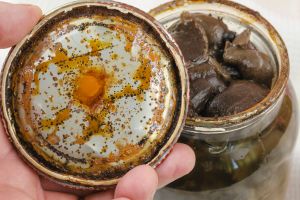

Have you ever opened a can of food from your stockpile that had you second-guessing?
Whether the can in question was bulging, dented, or the “use-by” date just faded away, there comes a time when we have to make a choice: to toss it or eat it anyway. But, how do you determine if it’s still safe to eat or not?
Sometimes, damaged or old cans of food are perfectly safe to eat despite their strong odors or funny appearances. Other times, they can be dangerous or even deadly without any smell at all.
In this article, we will discuss the deadly foodborne illness Botulism and how this silent killer can invade your emergency food stockpile.
We’ll also discuss some of the food types generally affected by this toxin, some commonly reported physical symptoms of Botulism poisoning, and tips and tricks to help reduce or eliminate the risk of Botulism in your kitchen.
What Is Botulism and Why Is it so Dangerous?
If you preserve food for your stockpile, you’ve undoubtedly been warned about Botulism before – but, what is Botulism exactly, and is it still a risk today?
Clostridium botulinum is a common bacteria that is found almost everywhere on Earth. By itself, it doesn’t tend to make people sick.
However, given enough time in the right environment, this bacteria produces spores that create one of the world’s most dangerous toxins.
Botulinum toxin is one of the most lethal substances known to humans and can cause a serious, deadly illness called Botulism.
You can’t see, smell, or taste botulinum toxin, but a small taste of affected food can kill you if left untreated. Botulism can cause death and is a serious emergency that requires quick medical intervention.
However, there are many more other illnesses that could become deadly in a crisis. To prepare for worst-case scenarios, you should consider stockpiling a variety of medical supplies that can handle everything from minor cuts to serious injuries.
Learn more here about the 10 medical supplies you need to stockpile before it’s too late. With the right supplies and knowledge, you can be better equipped to handle unexpected emergencies and safeguard your health.
The Signs and Symptoms of Botulism
Identifying a case of Botulism is a survival skill in itself. Learning how to spot symptoms is especially important if you plan on giving home-canned foods away to neighbors, friends, and family.
Symptoms of Botulism usually begin within a few hours or up to 72 hours after contamination.
Clostridium botulinum toxins disrupt normal nerve function and can cause a range of alarming symptoms: muscle weakness, difficulty breathing, difficulty swallowing, difficulty speaking, respiratory failure, blurred vision, facial weakness, drooping eyelids, nausea, paralysis.
If you or someone you know is experiencing symptoms of Botulism after consuming potentially contaminated foods, it’s important to seek medical diagnosis immediately.
An antitoxin may be administered that can attach itself to the toxins and help prevent further nerve damage. However, It can’t repair nerve damage that has already been done so it’s important to get medical attention as soon as possible.
Common Causes of Botulism in Food
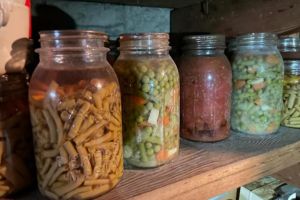 Eating improperly preserved, canned, or contaminated food is the biggest cause of Botulism. However, this deadly toxin is still pretty rare thanks to the specific anaerobic environment it needs to thrive.
Eating improperly preserved, canned, or contaminated food is the biggest cause of Botulism. However, this deadly toxin is still pretty rare thanks to the specific anaerobic environment it needs to thrive.
Here are a few of the most common causes of Botulism in food, and how to limit your risk:
Fermented Foods
Although generally regarded as “safe” with minimal risk of Botulism, fermented foods like sauerkraut, kimchi, and sourdough bread starter may pose a risk of developing Botulism or other bad bacteria if not made, handled, or stored properly.
When fermenting foods at home, it’s important to deep-clean and sanitize all equipment before using. Always use fresh ingredients, and ensure the correct measurements and type of salt are being used.
For the utmost freshness in your ingredients, you should grow your own vegetables using this guide. This ensures that you have full control over the freshness and quality of your produce
It’s also important to keep food completely submerged in the brine during the entire fermentation process for the best and safest results.
Low-Acid Foods
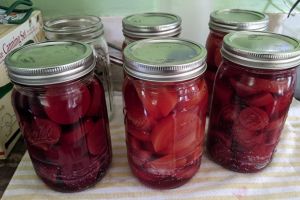 Some commonly canned low-acid foods include vegetables like asparagus, green beans, beets, corn, potatoes, and certain meats, to name a few.
Some commonly canned low-acid foods include vegetables like asparagus, green beans, beets, corn, potatoes, and certain meats, to name a few.
Generally speaking, foods that have a pH above 4.6 are considered “low-acid” foods and are considered “riskier” when it comes to botulism.
Low-acid foods provide the perfect environment for Botulinum toxins to grow. So, it’s especially important to be cautious when home-canning or purchasing cans of low-acid foods from the store.
The safest way to process low-acid foods is with a pressure canner. A pressure canner can reach temperatures as high as 250 degrees Fahrenheit which is hot enough to destroy the spores that produce botulism toxin.
Not Using Enough Sugar
High-sugar environments can preserve food well enough to help keep bad bacteria away. However, low-sugar environments may be more prone to Botulism spores.
Related: How To Make The Long-Lasting Native American’s Wojapi Sauce
For recipes like jams, jellies, preserves, chutneys, etc., it’s important to use enough sugar to preserve the contents and help prevent the risk of Botulism.
Not Using Enough Salt
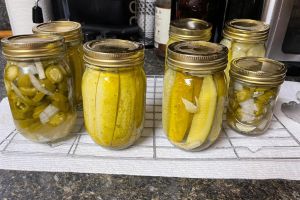 When canning, pickling, or fermenting food, it’s important to use clean, sterilized equipment, and the correct amount of the right kind of salt.
When canning, pickling, or fermenting food, it’s important to use clean, sterilized equipment, and the correct amount of the right kind of salt.
Not using enough salt or using table salt in place of pickling salt or sea salt could potentially result in an unsafe food product.
Tips and Tricks for Avoiding Botulism in Home-Canned Foods
Buying Dented Cans vs. Canning Your Own Food
When purchasing canned food at the store, always inspect the can for bulges and dents. Some canned goods, like low-acid foods, are more risky than others.
Canning food at home is a good way to make sure you have total control over the canning process from choosing the ingredients to sealing the jar. This may result in a higher quality food product with a reduced margin for error. Use this to make sure you avoid foodborne illnesses and enjoy the satisfaction of safe, homemade canned goods.
Use Invaluable Kitchen Tools
Many traditional home cooks don’t like using measuring equipment. However, using kitchen tools such as a kitchen scale and a food thermometer can provide an added level of certainty in the kitchen.
Knowing that foods are measured out and heated to a safe temperature before canning can help you and your loved ones stay far away from Botulinum foodborne toxins.
Pressure Canner or Water Bath for Home Canning?
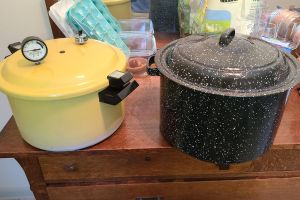 Using a pressure canner is generally considered the safest and most reliable option for canning low-acid foods, such as vegetables, meats, fats, and various ingredients.
Using a pressure canner is generally considered the safest and most reliable option for canning low-acid foods, such as vegetables, meats, fats, and various ingredients.
Alternatively, a water bath canner can be safely used to can high-acid foods, such as fruits, tomatoes, and pickles.
However, according to the FDA, a pressure canner is really the best way to ensure food safety when canning low-acid foods.
Sanitize all Equipment Before and After Using
Keep all canning, pickling, and fermentation equipment clean, sanitized, and properly stored.
Additionally, work surfaces and utensils should also be cleaned and disinfected before preserving food in your kitchen or workspace.
Keep on Top of Good Storage Habits
Store finished canned, pickled, and fermented foods in a cool, dark place. Before consuming, check for signs of spoilage – like mold, off-coloration, or rancid smells.
It’s a wise idea to do a quality and inventory check at least once or twice a year to monitor for vulnerabilities like pests, leaks, or other potential contamination issues.
Botulism is a serious foodborne illness that can be caused by improperly canned, pickled, or preserved foods.
However, having canned or other preserved food in your stockpile can also ensure you and your family will be fed throughout the year.
This is why it’s important to at least be aware of the causes and symptoms of botulism, as well as common sources of the toxin.
By following proper food preservation techniques and taking prevention tips, you can reduce your risk of botulism and safely enjoy the fruits of your labor.
You may also like:
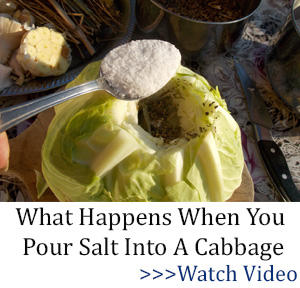 11 Expensive Items That Used To Be Cheap
11 Expensive Items That Used To Be Cheap
What To Do With All Your Frozen Food Once The Power Goes Out (Video)
The Only Things That Preppers Should Know About Archery
How to Build an Endless Hot Water System (Without Electricity)

